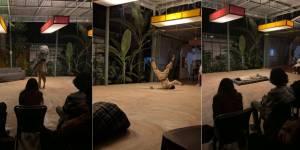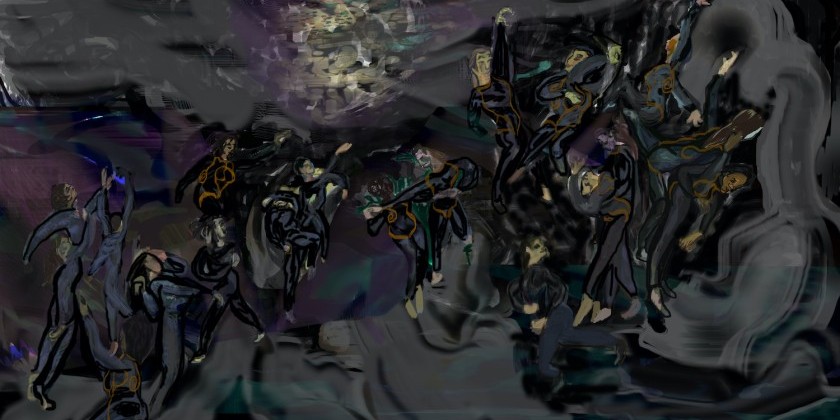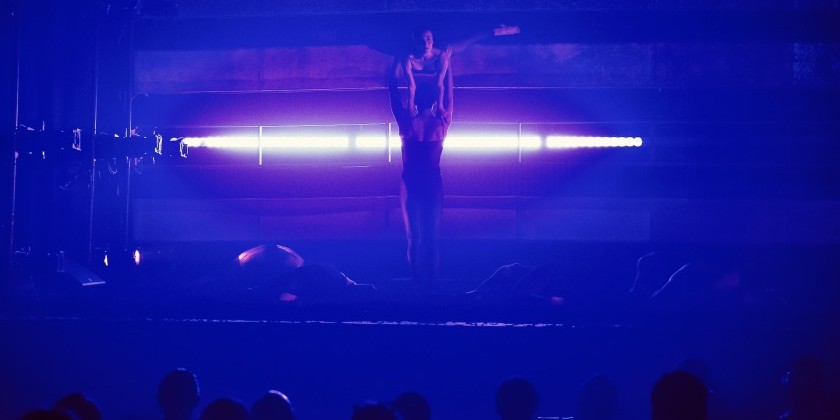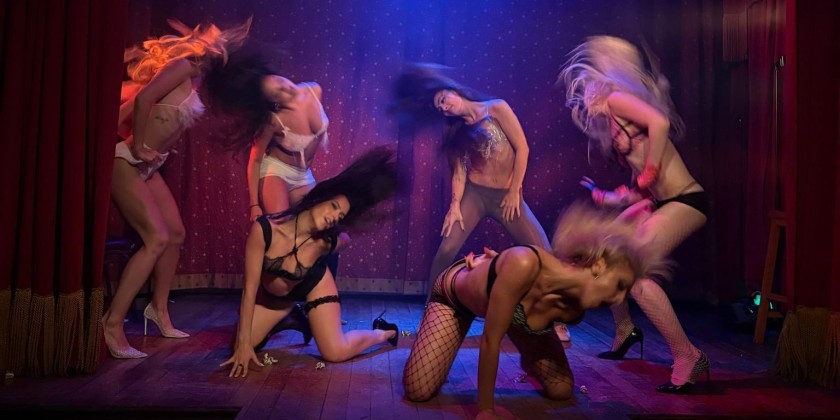AUDIENCE REVIEW: Mimi Garrard Dance Company at New York Live Arts, Professor Henning Rübsam with his Dance History Students at Ailey/Fordham
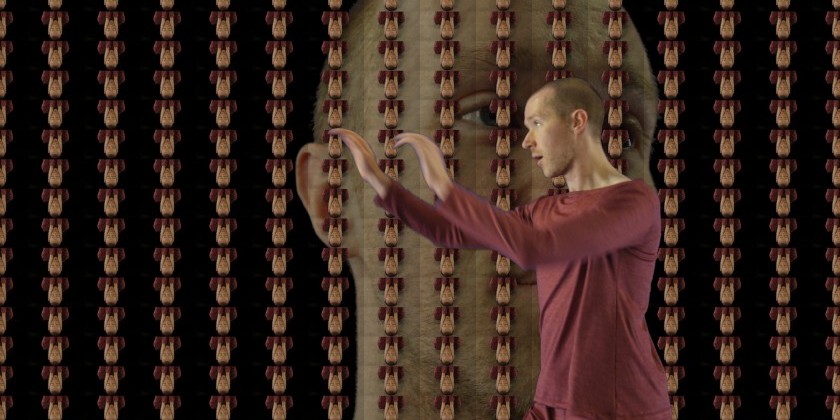
Performance Date:
10-13-19
Freeform Review:
Henning Rübsam: Choreographer and multi-media artist Mimi Garrard has collaborated with fine solo dancers for many years. After having dedicated several evenings to one particular interpreter, Garrard chose to present four different collaborators on October 13. I hold Garrard’s work in high esteem and was delighted to take students of my dance history class in the Ailey/Fordham BFA program to her show.
Natalie Ng: On Sunday, October 13th, I had the pleasure of seeing a show choreographed by Mimi Garrard at New York Live Arts. The program included four solos performed by Sarah Daley-Perdomo, Michael Francis McBride, Samuel Roberts, and Austin Selden.
One of the most interesting factors of the show was the combination of simple, expressive solos and a video backdrop that mimicked and played on the movements performed. This was also one of the first shows I’ve seen that have incorporated other art forms, specifically the use of video and projection. This added another element to the already thoughtful and expressive solos, and I commend Garrard’s creativity.
Mollie Petrizzo: Garrard’s use of lighting and costume design along with video footage of the dancers repeating specific movement within their solo was brilliant, since the coordination of these elements along with each dancer’s movement worked seamlessly to express their individual message. I have never seen a program that involved both dance and video playing such equally important parts. The program was unique in how the performers were also listed as co-choreographers in their solos.
Mary-Beth Rodgers: The program was an intersection of dance and video, and throughout the night the balance between both mediums was explored and questioned. The first three pieces were premieres, beginning with Flux of Time choreographed by Mimi Garrard with soloist Sarah Daley-Perdomo. This first solo had movements that were slow and methodical, the dancer sinking into deep lunges and crossing the stage like a lioness stalking her prey. Her focus point changed throughout the solo, but her intention never wavered. Her presence filled up the stage, and the video behind her reflected the power she commanded as she crossed from stage left to stage right both in person and on screen. The audience roots for her the whole time, hoping she will secure what she has been stalking.
NN: The first thing I noticed was Sarah’s focus. In her solo, there was a lot of crawling and walking with a very direct intention that drew in the audience. The music, composed by Jonathan Melville Pratt, was filled with different sounds that people wouldn’t normally consider ‘music.’ Sarah’s costume, by Mindy Nelson, was an intricately patterned unitard which matched the pattern of the video backdrop. At moments her body almost seemed to be transparent because her costume blended with the background.
Katryn Mantyh: Dreaming of Broadway was the title of Michael Francis McBride’s solo which was a contrast to the first solo. I was first drawn in by the cheekiness of McBride dramatically reciting the famous Chorus Line bridge “God, I hope I get it, I hope I get it… how many people does he need.” Like Sarah’s solo, there was an intensity to his solo, but here were comical moments which were to bring attention to some of the cheesiness asked for in the Broadway world. Dressed in Breton stripes like the French Navy, McBride was ready to do his duty and perform for any audience. A repeating motif of snapping, something quintessentially jazzy, occurred throughout the piece which could have been seen as a way to make sure the audience was constantly engaged, but it could also be for the dancer to snap out of his trance. This was my favorite piece out of the whole show and after watching, I wanted to know more about how this piece came to be and what it was really about.
Lauren-Frances Wood: The dancer in the third piece was amazing. Together with the lighting and his costume, he transformed into a beautiful creature. I was entranced by his quality and intention but the projections distracted me. The dancer alone could have made that piece phenomenal.
MP: Samuel Roberts' solo, Sam’s Journey, in my opinion, used multimedia in a different way than the previous two solos. While the footage itself was very similar, the context it was used in, in terms of the live dancing, was different. The footage of Samuel’s movement was primarily played when he would run offstage briefly, then would change into a different visual effect while he was out onstage. As someone who hasn’t watched many multimedia works, I appreciated the ability to watch Samuel dance while also being able to fully concentrate on the effects when he ran offstage. It was a different experience than the other two solos.
NN: His costume was made of green velvet and the green lighting used accentuated the choreography beautifully. This was the first solo of the night where the dancer went off stage. I thought that gave the audience a moment to really take in the video. However, I also thought that the video was too distracting while he was dancing. I found that some of the most powerful moments were when the background was very simple, almost plain, and it was just Sam.
MBR: Garrard and Samuel Roberts used the screen behind the dancer very effectively. The editing and layering of colors and shapes created a striking narrative between the dancer captured in the camera and the dancer free on stage. It was captivating to see how the soloist danced with his recorded counterparts and stayed in time with himself from the past, even when the editing made it so there were more than 20 recorded versions of the soloist on the screen.
NN: The last solo was Cosmic Man danced by Austin Selden. This was the only solo that wasn’t premiering that night. I also found the video in this piece to be a bit distracting as it was filled with many geometric shapes. Also, while you could clearly see the dancers’ expression and focus in the previous solos, I felt like the lighting didn’t capture Austin’s features as much as I’d like. Sometimes it just felt like he was just a body in space.
KM: Mimi Garrard’s work has a pace of its own, which is one of the reasons why I think it separates her from the rest. The other reasons include how involved she is in the process from start to finish. In the program, her name is listed 16 times under various roles from choreography to camera and editing. To tie the night up in a nice bow, we had the pleasure of talking to Samuel and Mimi herself after the show. Samuel gave insight and confirmed just how collaborative the process was. I have much respect for her work, and I commend her for the versatility she brings to the dance world.
Author:
Henning R
Photo Credit:
Courtesy Mimi Garrard Dance Company




